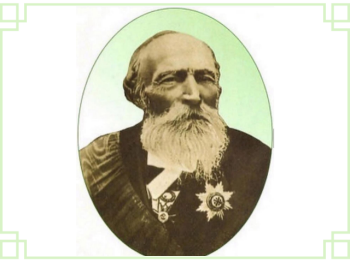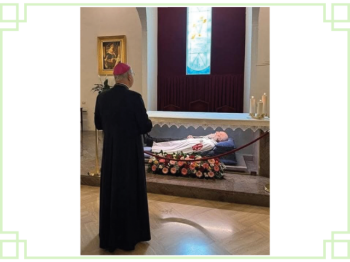The Canonization of Bartolo Longo

The decree for the future canonization of Bartolo Longo, Knight of the Order of the Holy Sepulchre, was signed by Pope Francis during his final hospitalisation at the Gemelli Hospital last winter. It was his successor, Pope Leo XIV, who set the date for the celebration during the first Consistory of the new pontificate, held on June 13. Bartolo Longo will therefore be canonized on October 19. In the following article, Ambassador Leonardo Visconti di Modrone, Governor General of the Order, retraces the life of this remarkable witness to the faith.
On February 25, devotees of Our Lady of Pompeii around the world rejoiced at receiving a long-awaited announcement: from his hospital bed, Pope Francis had approved the canonization of Bartolo Longo, who had previously been beatified by Pope John Paul II on October 26, 1980.
Bartolo Longo was laid to rest in the Shrine of Pompeii, in a chapel dedicated to him. He was adorned in the cloak and insignia of a Knight Grand Cross of the Equestrian Order of the Holy Sepulchre of Jerusalem.
But who was this extraordinary man? Bartolo Longo played a pivotal role in the founding of “New Pompeii,” the city that grew around the Shrine of Our Lady of the Rosary.
In 1872, Longo went to Pompeii Valley and was deeply struck by the spiritual and material poverty of the population. Convinced of the need for a religious and social rebirth, he began to promote devotion to the Rosary. In 1875, with the arrival of the painting of Our Lady (November 13), he started the construction of a shrine dedicated to the Virgin, the first stone of which was laid on May 8, 1876 and consecrated a year later on May 7, 1891.
Around the shrine, Bartolo Longo established a network of charitable and educational institutions. These included orphanages for girls, homes for the children of prisoners, a printing press to publish religious materials and promote devotion to the Rosary, housing for workers, and a music school. These religious and social initiatives laid the groundwork for the development of other essential infrastructure such as a railway station, post and telegraph offices, roads, aqueducts, and electrical networks.
Through his tireless efforts, Bartolo Longo helped establish the Shrine of Pompeii as a major Marian pilgrimage site. In addition, he became the driving force behind the birth and growth of the modern city of Pompeii, transforming a oncedesolate valley into a vibrant center of faith, charity, and social progress.
Pope Francis’ decision to canonize Bartolo Longo is a tribute to a modern saint and a visionary ahead of his time. With a prophetic outlook that united faith and charity, Bartolo Longo anticipated the themes of Pope Leo XIII’s Rerum Novarum and embodied the Church’s concern for the most vulnerable. He stands as a shining example of lay holiness in action.
Bartolo Longo’s faith, born of a profound conversion from secularism and atheism, was both strong and sincere, as reflected in the intensity of his prayers. In his Supplication to the Queen of the Most Holy Rosary, composed in 1883, we find deeply moving expressions of devotion, for example, “[…] with the confidence of children we expose our miseries to you […]”; “we will not part from your knees until you have blessed us”; and, “you will be our comfort in our hour of agony: to you the last kiss of life as it fades away.”
Moreover, his faith was expressed above all through a profound commitment to charity and love for the marginalized. This was most evident in the creation of innovative initiatives for the care and education of orphans, the destitute, disadvantaged minors, and the children of prisoners.
The canonization of Bartolo Longo, who was an illustrious member of our Order, honored with the distinction of Knight Grand Cross by Apostolic Brief of Pope Pius XI on March 5, 1925, is an event of extraordinary significance for all of us, Knights and Dames.
If we look at Article 4 of our Constitution, which outlines the commitments of a member (personal renunciation, generosity, courage, solidarity, concern, involvement, and cooperation) we can clearly see how Bartolo Longo exemplifies each of these virtues.




 The Assessor of the Order and Prelate Archbishop of Pompeii, Msgr. Tommaso Caputo, in prayer before the relic of Blessed Bartolo Longo, in the Shrine of Our Lady of the Rosary. The Shrine was founded by the future Saint near the ancient city destroyed by Mount Vesuvius.
The Assessor of the Order and Prelate Archbishop of Pompeii, Msgr. Tommaso Caputo, in prayer before the relic of Blessed Bartolo Longo, in the Shrine of Our Lady of the Rosary. The Shrine was founded by the future Saint near the ancient city destroyed by Mount Vesuvius.